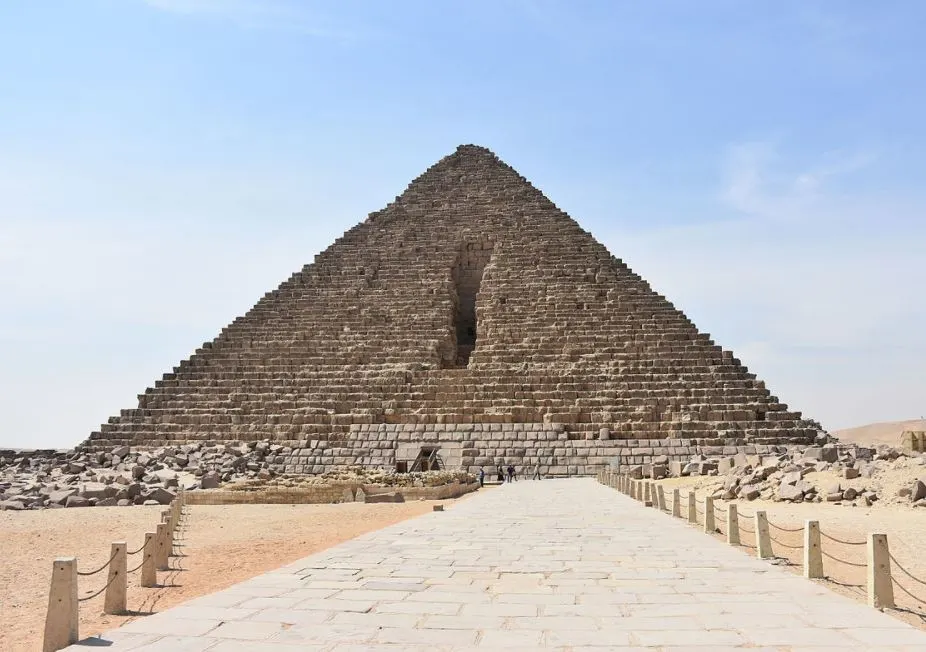The Giza Plateau to the southwest of Cairo is dominated by 3 large and numerous small pyramids that are adjoined by several ancient Egyptian temples.
In this post, we’ll take a closer look at one of these as you’ll discover the ultimate list of interesting Pyramid of Menkaure Facts, one of the most fascinating landmarks in Egypt!
1. It’s one of the 3 main pyramids of the Giza necropolis
The Pyramid of Menkaure is one of the 3 huge pyramids in the Giza Necropolis, a vast mortuary complex located just outside of Cairo. The other ones are the Pyramid of Khufu, also known as the “Great Pyramid of Giza” as it’s the biggest of the 3, and the Pyramid of Khafre, the second-biggest.
This enormous complex is located on the Giza Plateau, an elevated area just outside of Egypt’s capital at about 60 meters (196 feet) above sea level.
Apart from these 3 fascinating pyramids, the complex also features multiple mortuary and valley temples, monuments such as the Great Sphinx of Giza, and multiple satellite pyramids for the pharaoh’s wives.
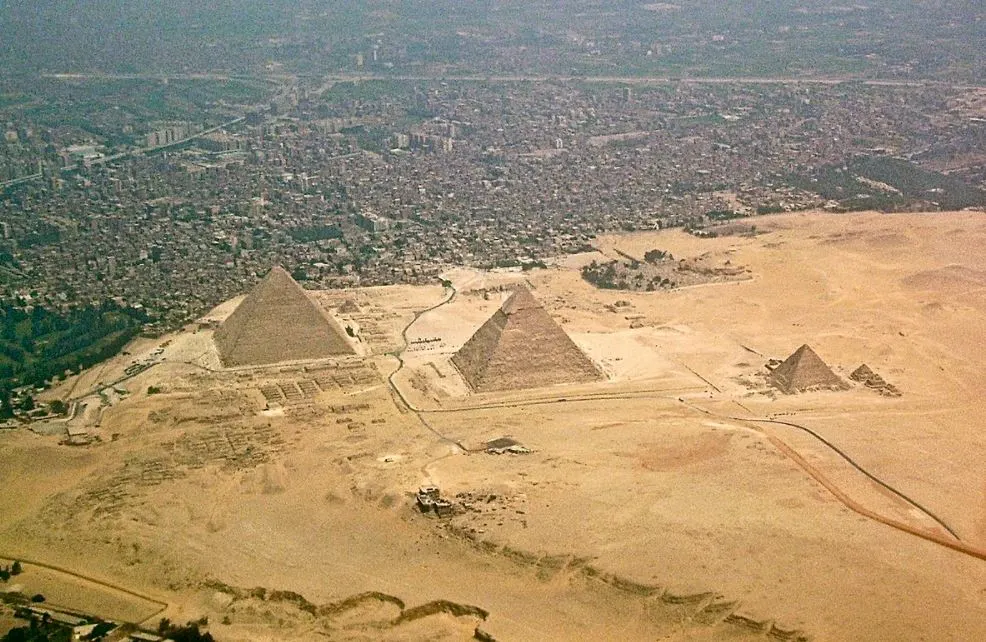
2. Even though it’s the smallest, it’s still bigger than it appears to be
If you see the aerial view of this vast mortuary complex, you would assume that the Pyramid of Menkaure is relatively small. It’s pretty much dwarfed in size by the enormous pyramids of Khufu and Khafre.
Khufu’s pyramid was the tallest structure in the world for over 3,800 years and still stands 138.8 meters (455 feet) tall from an original height of 146.7 meters (481 feet).
It’s also considered to be an ancient wonder of the world. It was even included in the list of 7 new wonders of the world as it’s the only structure still standing from the ancient list.
The Pyramid of Menkaure still stands 61 meters (200 feet) tall from an original height of about 65 meters (213 feet). It also has a base length of 102.2 by 104.6 meters (335 feet × 343 feet).

That’s the equivalent of the length of a football pitch, which is anything but small, right?
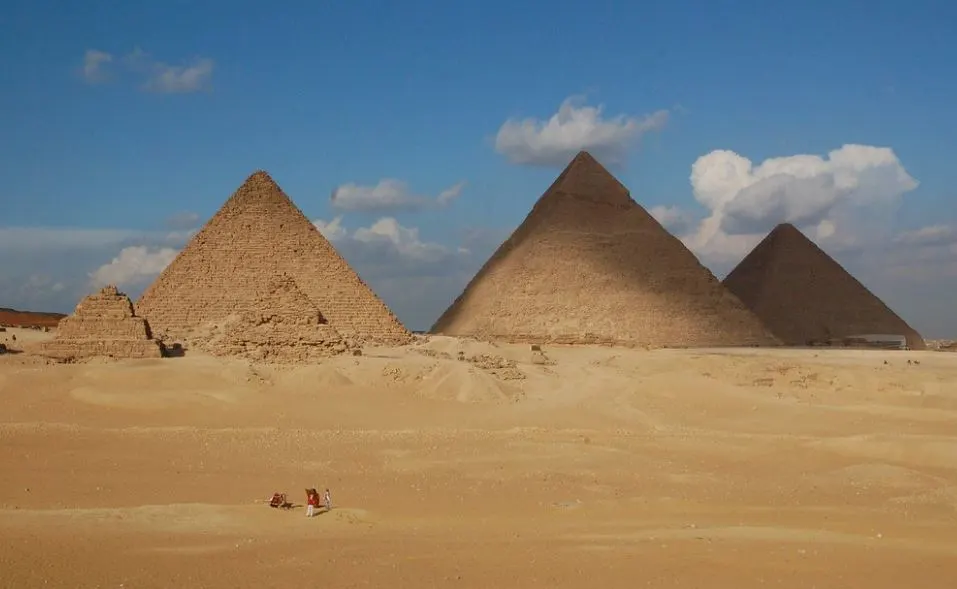
3. It was built as a tomb for the pharaoh with the same name
In Ancient Egypt, the pyramid was originally referred to as “Menkaure is Divine,” and even though the reign of this particular pharaoh from the 4th Dynasty remains relatively obscure, we can be positive that he was the one who commissioned it.
The Fourth Dynasty lasted from around 2613 to 2494 B.C. and archaeological evidence makes us suggest that Menkaure was the son and successor of Pharaoh Khafre, the son of Khufu, both the builders of the two largest pyramids at Giza.
Because of the size of his pyramid, it’s clear that he didn’t want to outdo both his father and grandfather.

4. The pyramid’s exact construction date remains unclear today
The reign of Pharaoh Menkaure isn’t as clearly described as that of his predecessors, so we are not certain when exactly his pyramid was constructed. It’s assumed that his reign started around the year 2530 B.C. and that he reigned anywhere between 18 and 22 years.
Artifacts have been found depicting the Pharaoh with two of his wives named Rekhetre and Khamerernebty. His successor was named Shepseskaf and it’s assumed that he completed the temple complex near the Pyramid.
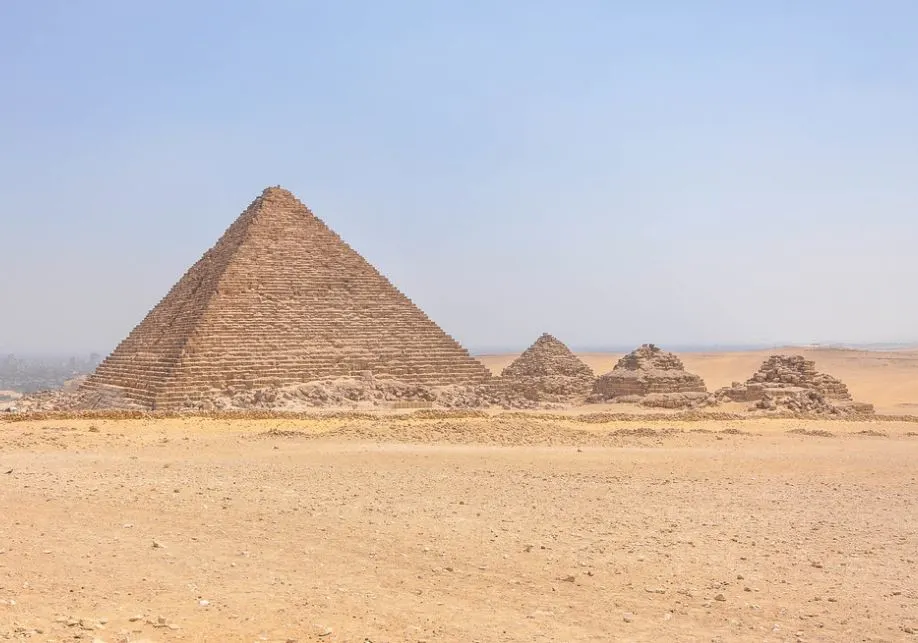
5. It was built with granite that came all the way from southern Egypt
The first 16 layers of the exterior were clad in Aswan red granite. This means that these enormous stones were quarried in the south of Egypt and transported all the way north to the area around Cairo!
The lower sections of the pyramid give us a clear indication as to what an enormous task this must have been as these are huge stones that were transported on the Nile River for over 800 kilometers (500 miles)!
The upper sections of the pyramid were clad with locally quarried Tura Limestone which was the same method used as for the other 2 great pyramids at Giza.
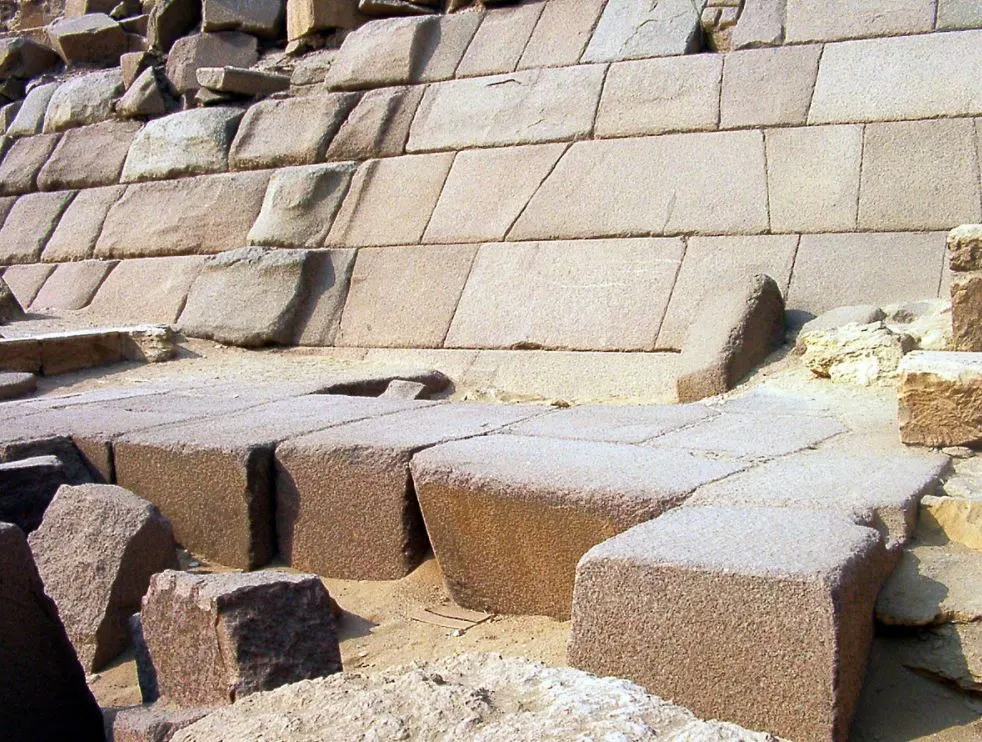
6. The pyramid was left unfinished which is great for archaeologists
The state of the base of the pyramid and the unfinished upper section is a clear sign that Menkaure most probably never saw his tomb completed. This is also most probably the reason why the upper section was clad with local Tura Limestones.
Did Menkaure overplay his hand here by using red granite quarried all the way down south and because of that lost precious time to complete his pyramid? We’ll never know but everything points in that direction, including the fact that his successor completed his mortuary temple complex next to the pyramid.
All of this makes the pyramid one of the most valuable resources for archaeologists to understand the pyramid construction process.
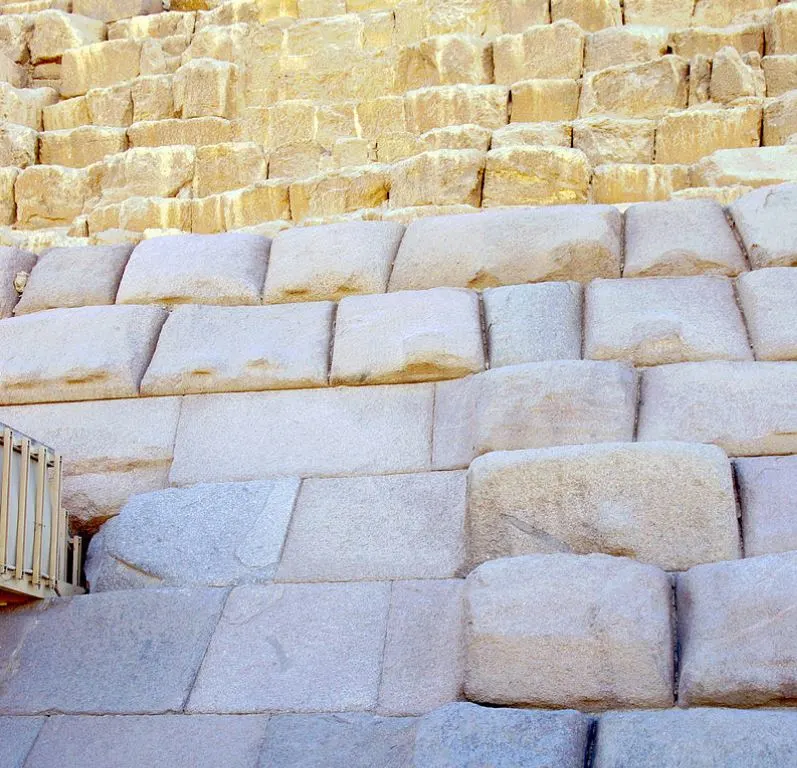
7. The sarcophagus sank in the Mediterranean Sea except for the lid
British Egyptologist Howard Vyse (1784-1853) discovered the most important proof that the pyramid was indeed built by Menkaure. He found the burial chamber on July 28, 1837, which featured a wooden anthropoid coffin that had Menkaure’s name inscribed on it.
This coffin contained human bones that were most probably not Menkaure’s as it’s assumed the pyramid was accessed in Roman times. Deeper into the pyramid he discovered another basalt sarcophagus that was richly decorated and contained the remains of a young woman.
Unfortunately, as this sarcophagus made its way to Britain, the ship that transported it named “Beatrice” wrecked and sank to the bottom of the Mediterranean Sea on October 13, 1838, somewhere between Malta and Cartagena. It was one of the few sarcophagi from the Old Kingdom that survived and today, only the lid of it can be admired at the British Museum in London.

8. The mortuary temples were built with enormous blocks
Just as the other pyramids at Giza, this one features additional structures in the form of a mortuary and a valley temple. The base of these temples was constructed with enormous local stones that weigh up to 220 tonnes.
Similar to the construction method of the pyramid, red granite stones were imported from Aswan that weighed up to 30 tonnes and were used in the lower sections. The top section of the temple was finished with crude bricks.
Certainly, the mortuary temple was also not completed yet at the time of Menkaure’s death because an inscription was found on one of its walls pointing out the completion by his son and successor Shepsekaf.
Made the temple as his monument for his father, the king of upper and lower Egypt.
Inscription found on Menkaure’s mortuary temple.
It’s also fair to assume that Menkaure was a popular and influential Pharaoh because additions to his temple complex were made as late as the 6th Dynasty, over 2 centuries later!
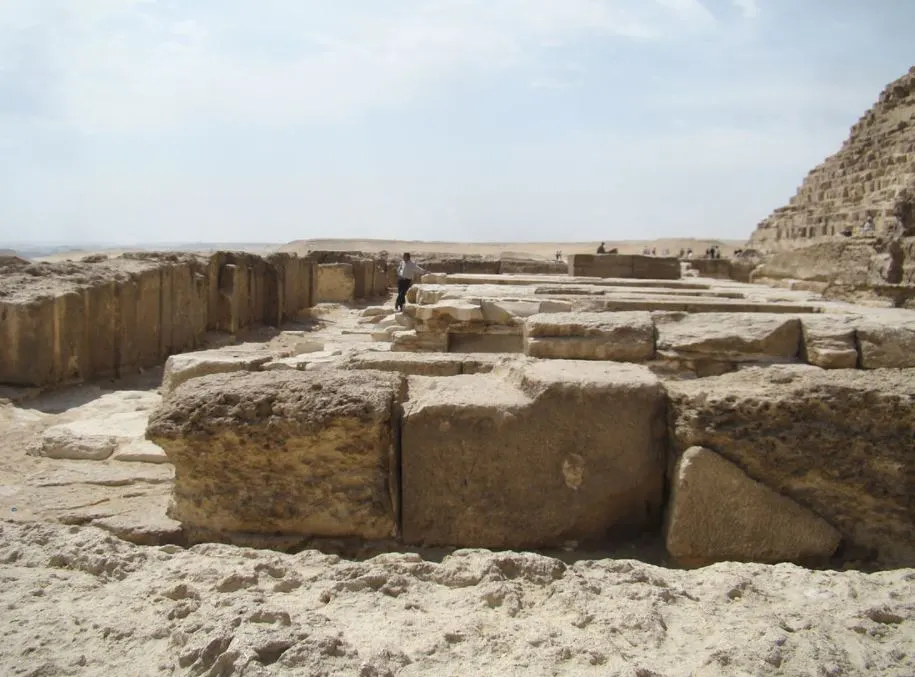
9. Only 1 of the 3 adjoining smaller pyramids was completed
The 3 additional and much smaller satellite pyramids are the so-called “Queen’s Pyramids” and were constructed for the Pharaoh’s wives. These pyramids are now referred to as G3-a, G3-b, and G3-c, and only the easternmost of the 3 is a true pyramid that was completed.
The main reason we can be positive that this eastern pyramid was completed is that a limestone pyramidion that capped the top of the pyramid was found nearby. The other two are step-pyramid such as the Pyramid of Djoser and only the inner features were completed.
Regardless of their apparently small size, the completed pyramid is a square that originally stood 28.4 meters (93 feet) tall and that has a base length of 44 meters (144 feet), which isn’t small by any means!
To give some reference with a modern example, one of the most iconic buildings in Paris, the Louvre Pyramid, has a height of just 21.6 meters (71 feet) and a base length of just 34 meters (112 ft), which means is quite a bit smaller than these satellite pyramids!
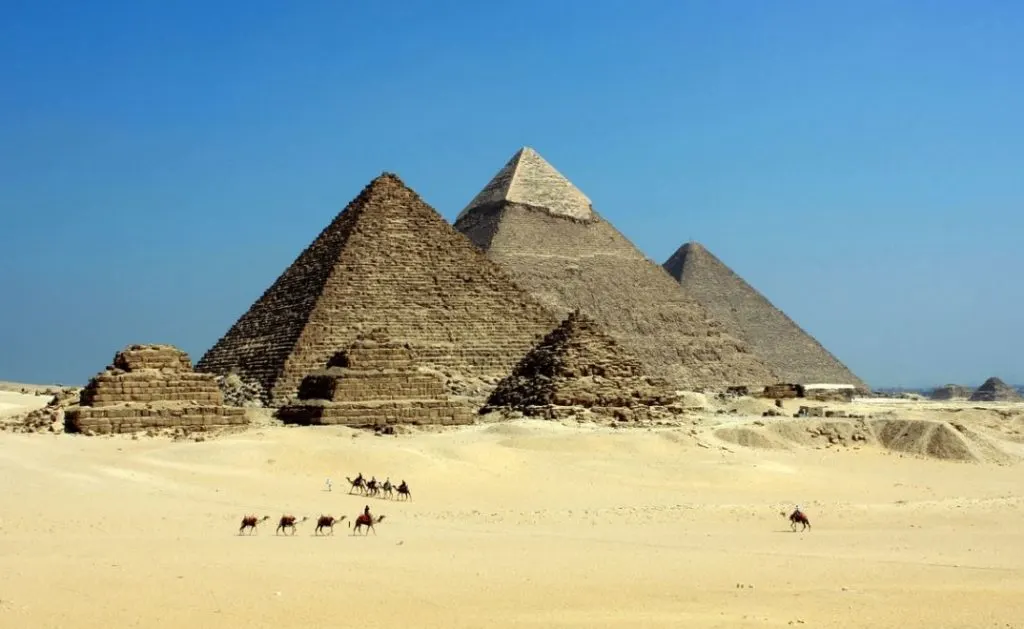
10. The Sultan of Egypt tried to destroy the pyramid but quickly gave up
In the year 1196, the son of Saladin and Sultan of Egypt named Al-Aziz Uthman had a great idea. He was going to destroy all the great pyramids of Giza!
At least, that was his vision. After 8 months of hard labor with a large number of people and by using ropes and wedges, they only managed to achieve what can be seen today.
They moved forward at a pace of 2 blocks every day, and every time a block dropped it buried itself into the desert sand below, something that required just as much effort to free it.
The poor sod gave up because he realized that he would never be able to destroy any pyramids in his lifetime, something that emphasizes the fact that these miraculous structures are here with us forever!
